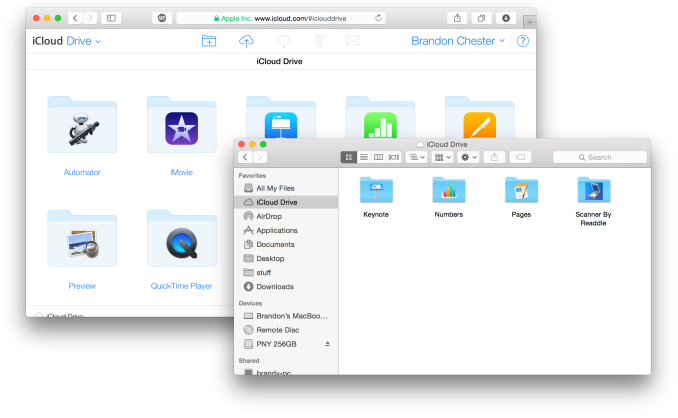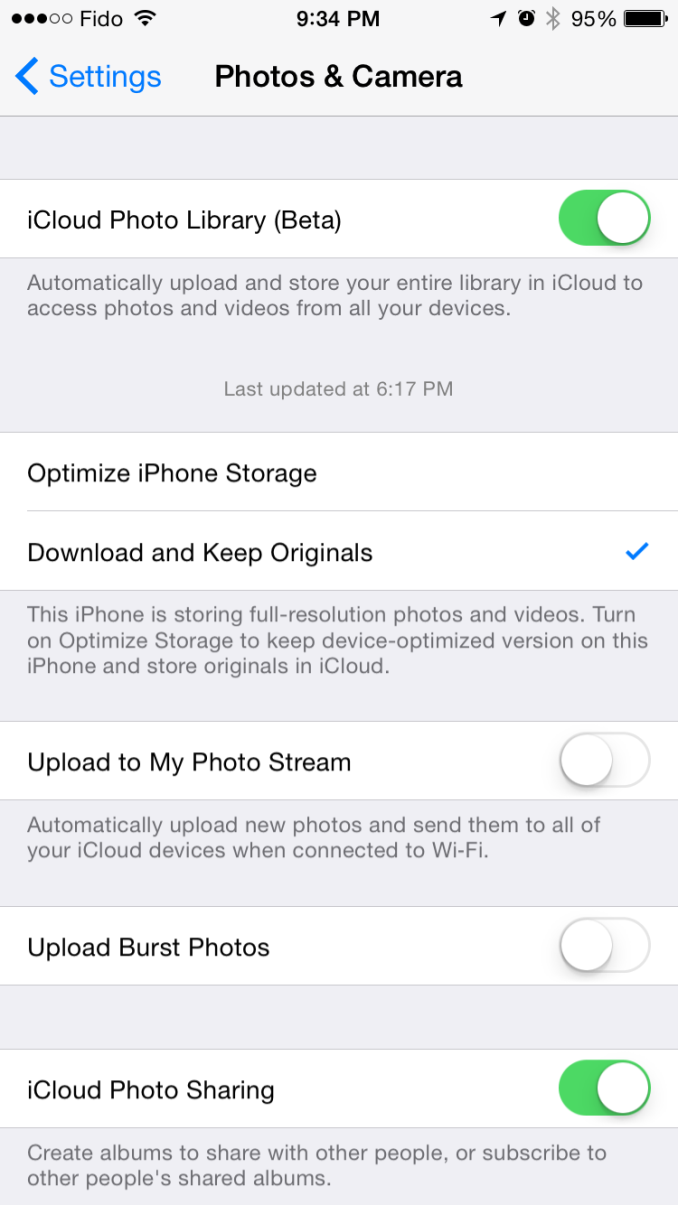A Look At OS X Yosemite And iOS 8.1
by Brandon Chester on October 27, 2014 8:00 AM ESTiCloud Drive and Photo Library
At WWDC 2014 Apple introduced a number of significant additions and improvements to their iCloud service for developers and consumers. On the user side we got iCloud Drive and iCloud Photos. Both of these features position themselves against the offerings from other companies in the increasingly competitive cloud storage space. Apple's advantage within their own ecosystem is how iCloud integrates with their own systems better than Dropbox, OneDrive, or Google Drive ever can. Integration cannot keep a service alive if it becomes stagnant though, and these two features are very necessary additions.
iCloud Drive
iCloud Drive is arguably the more important and interesting of the two features. In the past, iCloud has been something like a magic black box that users can never access or even look into. Files would be created in an application, sent to iCloud, and hopefully they would show up on your other devices. This type of model makes for a great document synchronizing solution, but it's not very good at some of the other things people have grown to expect from a cloud storage service. Apple had to build something that allowed users to manage their documents stored in iCloud, including the ability to add or remove files as needed without having to go into each individual iCloud enabled application.
As a file storage service, iCloud Drive functions exactly how you would expect. You can make folders, and upload files to those folders which can be accessed on any other device with access to iCloud drive. In addition to those files, iCloud Drive also houses the files for any iCloud enabled application. As you can see above, each iWork and iLife application also has its files accessible in iCloud Drive, along with third party iCloud enabled apps like Scanner by Readdle.
Your drive can be accessed in a few different ways. In OS X it's integrated right into Finder and is listed in Favorites by default. Windows users can download Apple's iCloud Control Panel to have it accessible via Windows Explorer. I've avoided the Windows solution because my past experience is that having iCloud Control Panel do anything with to Windows Explorer will make it crash Windows Explorer. While I haven't experienced that while using the new Control Panel 4.0 for the purposes of this review, I still don't trust it.
The third method is to access it from iCloud.com. You would think that with these 3 options, including a web based option, Apple would have every platform covered. Unfortunately they don't. There is no way to directly manage iCloud Drive from an iOS device because iCloud.com displays a special page with links to get information on setting up iCloud and installing Find my iPhone. Applications that integrate with iCloud have the ability to open documents stored in iCloud Drive using the document picker, but there's no way to move or delete other files. I don't know if this is just an oversight or if Apple doesn't want it accessible via mobile but it is honestly a necessary feature and I hope to see it added soon either through an app or through iCloud.com on iOS.
iCloud Photos
iCloud Photo Library was released with iOS 8.1 in the form of a public beta. I actually wrote about it in my initial iOS 8 review due to confusion regarding its availability. It was only near the end of Apple's beta cycle that they revealed SMS Forwarding and iCloud Photo Library would be arriving with a later release. On top of that, using the OS X Yosemite preview would cause the option to reveal itself on your iOS devices. As a result, my devices running the gold master build still had the feature and I was unaware that for most users it would not be accessible until October. But now October has come and we can take a closer look at iCloud Photo Library in its beta form. Users who want to try it out just need to opt into the beta in the Photos & Camera section of the Settings application. Doing so will change the name of Camera Roll to All Photos in the Photos app.
As I've stated before, iCloud Photo Library is not the same as Photo Stream. Photo Stream is really just a method of pushing your photos between all your devices. It relies entirely on local storage and the photos are removed from iCloud after 30 days. iCloud Photo Library keeps all of your pictures in the cloud, and keeps the most recent and frequently accessed ones locally on your device. This is often referred to as nearline storage. Users can also specify to download copies that are optimized for their display resolution which will save space compared to storing full resolution copies on local storage.
iCloud Photo Library is definitely a great feature, but right now the experience is missing a few key things. On iOS it works very well due to how the entire photo experience is within the Photos application. On OS X it's still lacking. Some people may feel it's unfair to criticize certain aspects due to the fact that the feature is technically a beta, but oversights need to be addressed for them to be fixed.
The biggest issue for me is that Apple's Photos application for OS X won't be shipping until early 2015. That's quite a long time after the initial release of Yosemite, and an even longer time after iOS 8 was released. This means that there is currently no way to access photos stored in iCloud on a Mac unless it is done through the web interface. It's an okay solution for now, but the web interface is nothing spectacular. It's essentially the iPad Photos app interface but in a web browser. My biggest issue with it is that it doesn't actually scale. The Safari window with iCloud Photos above is as small as you can make the window without introducing horizontal scrolling. Making the window larger doesn't show more photos on the screen, it just makes the thumbnails bigger. This contrasts with iCloud Drive's web interface which does scale the arrangement of folders based on the size and shape of the window.
There is definitely a lot of pressure involved in trying to ship two major operating system updates around the same time every year, and to pack in new features that work across both of them. Apple made it clear at WWDC 2014 that Photos on OS X wasn't going to be ready until 2015, but I think the issue created by that could have been addressed much better by updating iPhoto to support iCloud Photo Library rather than relying on the web interface.














173 Comments
View All Comments
p_giguere1 - Monday, October 27, 2014 - link
Apple offers the max RAM the motherboard can support (16GB) at purchase.The only reason you might want to upgrade RAM yourself is to buy the 8GB RAM model only to tell yourself "I'll upgrade to 16GB down the road when RAM gets cheaper". You might save something like $100 by doing that as opposed to ordering 16GB RAM right away.
So essentially, what you're complaining about is the equivalent of "The 13" rMBP is $100 to expensive for me", correct? Would you not complain if the price dropped $100? Not only would it be equivalent financially, but you'd benefit from 16GB RAM right away and wouldn't have to deal with the RAM upgrade process. Or is this more of a matter of principle?
Cheesetogo - Monday, October 27, 2014 - link
Apple does not charge market value for RAM.ant1pathy - Tuesday, October 28, 2014 - link
Nor do they for the raw aluminum that the frame is made of. No company charges market value for their materials, that's what makes them a company.name99 - Monday, October 27, 2014 - link
Enter a coherent argument, not a random series of rants.Are you upset with every phone vendor because they solder their RAM? Are you angry that you can no longer change the tubes in your TV set? Are you livid that you can't open a Chromecast and change the flash storage?
The fact that people could change their RAM on PCs was a weird temporary anomaly of the PC world; it will go away because of the inevitable laws of physics, just like the ability to change your FPU has gone away and the ability to change your GPU will go away soon. Soldered RAM uses less power (relevant today) and can be run at higher frequencies (relevant tomorrow). What Apple is doing will be done by every vendor in three years because physics demands it.
LostAlone - Tuesday, October 28, 2014 - link
But soldered components are blatantly anti-consumer. The ability to change units is not just for power users who like to upgrade, it's critical for being able to service units. Things break sometimes, and being able to fix that yourself is pretty important. How would you feel if your car needed you to call a qualified Honda technician to change a flat tire?And no, the ability switch around components is not just a temporary thing. That is how systems exist and have done literally since the dawn of the personal computer. The first generation of home computers were sold as kits that you physically had to assemble yourself, chip by chip.
Ever since then ever generation of hardware has been built around interoperability and upgrading. The only places where you get soldered on CPUs in the PC market is in embedded systems and similar super-low powered systems like many Atom boards that come with the CPU attached. In every other non-mac system you can swap out parts.
Look at standards like SATA and PCI-Express - They exist specifically so end users can expand a barebones system over time; add a USB 3.0 card or an SSD hard-drive to an aging machine to extend it's life, or add a RAID card and totally repurpose the system into a server. These are important choices. The ability to do more with your hardware than just what it was capable of doing in the box is central to what being a PC user is. You can do more. I still use my ten year old PC as my headless network file server, because I can, because I have the option to do that.
So no, fixing your own PC isn't going anywhere, nor is upgrading. Sorry. Not happening. I cannot imagine why you would think otherwise. Just because Apple does something doesn't make it a good thing, and scrabbling around to find reasons to justify it when in fact what they are doing is flipping consumers the bird and declaring that they don't think you are smart enough to fix something yourself.
Ever since Apple gave up and OSX became just a different operating system running on stock PC hardware they have been trying anything to convince people that they are somehow getting something magically better, even though it's literally the exact same hardware. The fact that they STILL refuse to sell the OS separate to the hardware, even when that hardware is just normal every day PC components that they have assaulted with a soldering iron, is just wrong. It's part of a brand image that still relies on a lot of good will from the days when Macs actually were something different. Well, they aren't. And most users would be radically better of installing OSX onto another manufacturers PC.
The way that Apple handles their desktop and laptop exo system sucks. Don't apologize for them.
ex2bot - Tuesday, October 28, 2014 - link
Whatever your platform of choice (esp. Apple), itis inadequate and ill-advised. Thus I urge, nay, command you to immediately adopt my preferred platform as the obvious technically and morally superior choice. I'll be watching.You have been warned.
sunnohh - Friday, October 31, 2014 - link
12 years as a computer tech and I left to become a stock broker because I could very clearly see that everything should be soldered onto a single component. It's physically faster, tremendously increases reliability (no ram and cpu to unseat), and makes business sense for Apple or anyone serious about making money selling hardware. The industry is moving away from add on tointegrated components Apple isn't the only one: virtually every major manufacturers hi end ultra books are built exactly this way.As computers get faster and more integrated, replace and throw away is the only valid model. Upgrading hardware is nothing more than sentimental; replacing hardware is more economical.
We live in a throw away culture and computing is the ultimate disposable; mores law necessitates this.
Just ask component manufacturers they'll tell you this is happening; their sales prove it.
Buk Lau - Wednesday, October 29, 2014 - link
phones have soldered ram because of form factor. you really think you can fit a SO-DIMM slot inside a case that's less than a quarter of an inch? where did you get the fact that soldered RAM uses less power and can run at higher frequencies? so you are saying your soldered ram can beat 3000mhz DIMM ram? your "physics" seems very out of placemonopodman - Wednesday, October 29, 2014 - link
It's funny because I consider retina MBP one of the first Apple laptops actually worth buying compared to top competitors even regardless of OS X vs. Windows.... I'm totally fine with 16gb of RAM (and I don't care if it's soldered as long as it makes motherboard smaller due to easier routing) or built-in battery (I'd rather have one with higher capacity fit into a smaller and lighter enclosure).appliance5000 - Friday, October 31, 2014 - link
dunno - running an entire heavy graphic oriented system of an 11" air - faster than the old mac pro. Pretty amazing - though I agree regarding difficulty in upgrading -what's acceptable with a laptop is not so much with a desktop.On the other hand the new macpro is a beast and you can add stuff to it to your heart's delight.